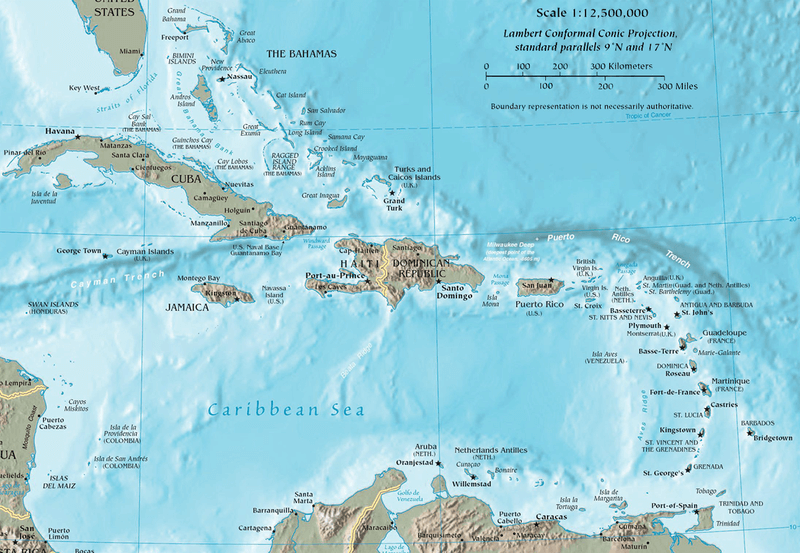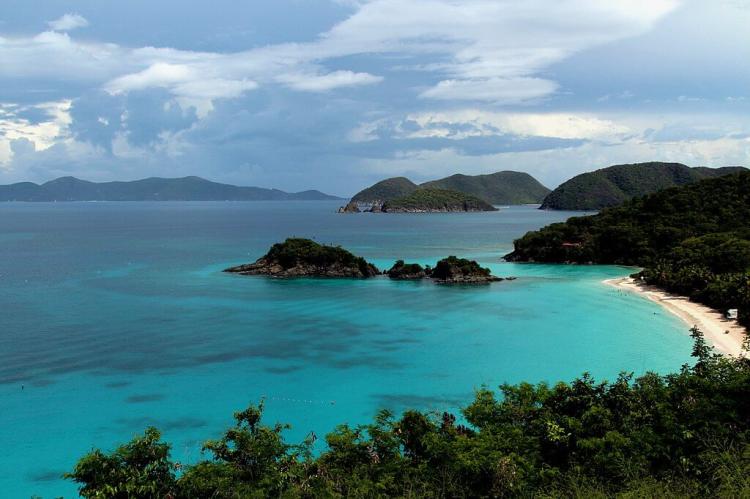Water Bodies of the Caribbean Region
The Caribbean region is renowned for its expansive network of water bodies, encompassing various gulfs, straits, bays, rivers, and lakes. These aquatic realms are defining features of the Caribbean's physical landscape and integral components of its ecological balance, climatic patterns, and economic vitality.
Water Bodies of the Caribbean Region
The Caribbean region, a mosaic of island nations and coastal territories, is renowned for its expansive network of water bodies, encompassing various gulfs, straits, bays, rivers, and lakes. These aquatic realms are defining features of the Caribbean's physical landscape and integral components of its ecological balance, climatic patterns, and economic vitality.
Spanning across the crystalline waters of the Caribbean Sea, these water bodies serve as vital conduits for life in the region. From the labyrinthine mangrove estuaries to the tranquil lagoons and bustling ports, each waterway harbors a rich tapestry of marine life, from vibrant coral reefs teeming with tropical fish to majestic sea turtles and elusive marine mammals.
Beyond their ecological significance, Caribbean water bodies are essential drivers of the region's economy. They support a vibrant tourism industry that draws millions of visitors each year to their sun-kissed shores. Whether snorkeling along vibrant coral reefs, exploring mangrove-lined waterways, or simply relaxing on pristine beaches, tourists are drawn to the Caribbean's aquatic wonders, fueling economic growth and providing livelihoods for countless communities.
Moreover, these water bodies serve as vital transportation arteries, linking Caribbean nations and facilitating the movement of goods and people across the region. From the bustling ports of major cities to the meandering rivers that wind through lush tropical forests, waterways have long been the lifeblood of Caribbean societies, connecting remote communities and fostering cultural exchange.
Here is a list of significant bodies of water found within or adjacent to the islands and landforms of the Caribbean region, along with brief descriptions:
Atlantic Ocean: The Caribbean islands are surrounded by the Atlantic Ocean to the east and north. The Atlantic Ocean provides access to the Caribbean from the eastern coast of the United States, Europe, and Africa.
Caribbean Sea: The Caribbean Sea is the central body of water in the Caribbean region, surrounded by the islands of the Caribbean and the mainland countries of Central America and South America. It is known for its turquoise waters, warm climate, and numerous islands and cays.
Gulfs and Bays
Gulf of Mexico: To the northwest of the Caribbean, the Gulf of Mexico borders the Yucatán Peninsula and provides access to the Caribbean Sea through the Yucatán Channel.
Gulf of Honduras: The Gulf of Honduras is located in the northwestern Caribbean, bordered by Belize to the west, Honduras to the south, and Guatemala to the west. It is known for its rich marine life and coastal mangrove ecosystems.
Gulf of Venezuela: Situated between Venezuela and Colombia on the northern coast of South America, the Gulf of Venezuela is a large inland body of water connected to the Caribbean Sea.
Gulf of Paria: The Gulf of Paria is a large body of water between Trinidad and Tobago and the eastern coast of Venezuela. It connects to the Caribbean Sea through Bocas del Dragón.
Gulf of Gonâve: The Gulf of Gonâve is located on the western coast of Haiti and is home to La Gonâve, the largest island in Haiti.
Guantánamo Bay, Cuba: Located in Guantánamo Province at the southeastern end of Cuba, Guantánamo Bay is the largest harbor on the island's south side. It is surrounded by steep hills that create an enclave.
San Juan Bay: San Juan Bay is a large bay located on the northern coast of Puerto Rico. It is home to the capital city of San Juan and is a popular tourist destination. San Juan Bay is also an important commercial port.
Montego Bay, Jamaica: Montego Bay is a popular tourist destination known for its white sand beaches, clear blue waters, and vibrant nightlife.
Negril Bay, Jamaica: Negril Bay is another popular tourist destination in Jamaica. It is known for its laid-back atmosphere and Seven Mile Beach, one of the longest beaches in the Caribbean.
Ocho Rios Bay, Jamaica: Ocho Rios Bay is a popular tourist destination in Jamaica, known for its many waterfalls, including Dunn's River Falls.
Anse Chastanet Bay, St. Lucia: Anse Chastanet Bay in St. Lucia is known for its black sand beach and crystal-clear waters.
Marigot Bay, St. Lucia: Marigot Bay is a picturesque bay in St. Lucia, known for its calm waters and lush green surroundings.
Soufrière Bay, St. Lucia: Soufrière Bay is a beautiful bay in St. Lucia, known for its black sand beaches and Pitons, two volcanic peaks that are the island's most iconic landmarks.
Rodney Bay, St. Lucia: Rodney Bay is a popular tourist destination in St. Lucia, known for its white sand beaches, clear blue waters, and lively nightlife.
Grace Bay, Providenciales, Turks and Caicos Islands: Grace Bay is a world-renowned beach located on the island of Providenciales in the Turks and Caicos Islands. It is known for its soft white sand, crystal-clear waters, and calm conditions.
Magens Bay, St. Thomas, U.S. Virgin Islands: Magens Bay is a popular beach located on the island of St. Thomas in the U.S. Virgin Islands. It is known for its white sand beach, clear blue waters, and lush green surroundings.
Trunk Bay, St. John, U.S. Virgin Islands: Trunk Bay is a popular beach located on the island of St. John in the U.S. Virgin Islands. It is known for its white sand beach, clear blue waters, and underwater snorkeling trail.
Carlisle Bay, Barbados: Carlisle Bay is a popular beach on the island of Barbados. It is known for its white sand beach, clear blue waters, and proximity to several shipwrecks.
Samana Bay, Dominican Republic: Samana Bay is a large bay located on the northeastern coast of the Dominican Republic. It is known for its beautiful beaches, whale-watching opportunities, and El Salto del Limón, a waterfall that cascades into a turquoise pool.
Straits and Passages
Mona Passage: The Mona Passage is a strait that separates the island of Hispaniola (shared by the Dominican Republic and Haiti) from Puerto Rico. It is an important maritime route.
Yucatan Channel: This channel, located between the eastern tip of the Yucatan Peninsula in Mexico and the western end of Cuba, connects the Gulf of Mexico with the Caribbean Sea.
Windward Passage: The Windward Passage is a strait between the eastern tip of Cuba and the western tip of Hispaniola. It connects the Atlantic Ocean to the Caribbean Sea.
Anegada Passage: Situated to the northeast of the British Virgin Islands, the Anegada Passage separates the British Virgin Islands from the neighboring island of Anegada.
Bocas del Dragón: Found between the island of Trinidad and the Venezuelan mainland, Bocas del Dragón is a strait that connects the Caribbean Sea to the Gulf of Paria.
Notable Lakes and Lagoons
Lake Enriquillo: In the southwestern Dominican Republic, Lake Enriquillo is the largest lake in the Caribbean. It is a hypersaline lake and lies below sea level.
Étang Saumâtre: Étang Saumâtre, also known as Lake Azuei, is the largest lake in Haiti and the second largest lake on the island of Hispaniola, after Lake Enriquillo in the Dominican Republic. It is a brackish lake with a higher salinity than freshwater but lower salinity than seawater.
Great Salt Pond: Great Salt Pond is a saltwater lake located on the island of Grand Turk in the Turks and Caicos Islands. It is the largest lake in the Turks and Caicos Islands and the second-largest saltwater lake in the Caribbean.
Boiling Lake: Boiling Lake is a volcanic lake located on the island of Dominica. It is the second-largest hot spring in the world and the largest in the Caribbean.
Grand Etang: Grand Etang is a crater lake located on the island of Grenada. It is home to various birds and other wildlife and is a popular hiking and swimming destination.
Lago Carraízo: Lago Carraízo is the largest artificial lake in Puerto Rico. It is located in the central part of the island and provides drinking water to the San Juan metropolitan area.
Laguna de Condado: Laguna de Condado is a small lagoon located on Puerto Rico's northern coast in the Condado neighborhood of San Juan. It is a popular tourist destination known for its calm waters and scenic views.
Laguna de San José: Laguna de San José is a large lagoon located on the northeastern coast of Puerto Rico, in the town of San José. It is a popular fishing destination and is also home to a variety of birds and other wildlife.
Notable Rivers
Cauto River: The Cauto River is the longest in the Caribbean, flowing for 343 km (213 mi) through the southeastern part of Cuba. It is a popular destination for rafting, kayaking, and fishing.
Yaque del Norte River: The Yaque del Norte River is the longest in the Dominican Republic, flowing for 298 km (185 mi) through the northern part of the country. It is an essential source of water for irrigation and drinking.
Grande Anse River: The Grande Anse River is the longest in Haiti, flowing for 266 km (165 mi) through the country's southwestern part. It is an important source of water for irrigation and drinking.
Artibonite River: The Artibonite River is the longest river on the island of Hispaniola, flowing for 368 km (229 mi) through Haiti and the Dominican Republic. It is the largest river in the Caribbean by volume.

Map of the Caribbean region with topographical features.
